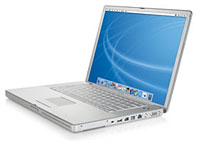It had been less than a year since I'd sold my cumbersome Dell
Inspiron 8200 notebook in favor of a 14" Apple iBook G4. Needless to
say, I was more than happy with the iBook - light, silent, and powerful
enough to do everything I wanted to do with it.
What more could I ask for?
It's said that all good things must end, and thus did my coveted
little iBook go before its time.
One Sunday morning, I lingered over to my desk only to find that my
iBook had frozen up right after coming out of sleep mode. I thought to
myself, "Well, isn't that interesting. Maybe it wants to be just like
the Windows machines on the network!"
I was forced to do a hard reset, and I was not welcomed by the
familiar gray Apple logo but with the dreaded Finder/question mark
folder icon.
Now this was a rarity indeed, and I quickly looked for my OS X
Tiger installation CD so I could check hard drive status. After booting
from that CD, I found that the machine wasn't even detecting my hard
disk.
Rather than taking it apart myself, I decided to head out to the
Apple Store where I had purchased the machine, since I was still under
AppleCare warranty. When I finally was able to see a Mac Genius, I
explained the situation, and they confirmed that hard drive was indeed
dead.
I had two options, send the machine in for service or barter for a
new PowerBook.
 I choose the latter.
I choose the latter.
I had to wait two-and-a-half weeks to receive my new 15" PowerBook, since everything had to go through
AppleCare, but it finally came in and I promptly picked it up. It was
everything I hoped it would be - except for one little thing, an
occasional beeping noise emanating from middle of the machine.
I researched the problem and found no concrete answer, but I
suspected it was an oscillator near the CPU. Regardless, I wasn't going
to live with it, so I returned it for another machine. Another trip to
the Apple Store, and I finally had my PowerBook - sans beeping.
This newest model from Apple, with its 1.67 GHz G4 processor, 15.2"
screen at 1440 x 960 resolution, 128 MB ATI Mobility Radeon 9700,
SuperDrive, and improved battery life, is nothing less than
spectacular. I promptly replaced the 512 MB DDR2 SDRAM with the maximum
2 GB and started to restore the data I had backed up on my old
iBook. All went according to plan.
The screen feels considerably bigger than 15" due to the higher
resolution, although I have had problems getting this resolution to
work with some games, most notably Call of Duty and Unreal Tournament
2004. However, Aspyr does offer suggestions for widescreen displays
that I haven't had a chance to test.
Mac OS X 10.4.3 runs incredibly smooth, even with the stock 512
MB of memory, undoubtedly due to the improved processor and bus
speed.
Another noteworthy feature is the digital sound port, which I've
used a few times, and I can really notice the difference in sound
quality, along with the improved integrated speakers (in comparison to
the iBook).
The new trackpad, which allows me to use both fingers to scroll up,
down, left, and right, takes some getting to used to, but after two
weeks of using it's now invaluable and used every single day.
Needless to say, despite having gone through quite a bit to get a
working machine, I'm very happy with my new PowerBook, and I'm sure
it'll hold its own for the next few years, even when compared to the
upcoming Intel Macs.
One thing is for sure, in a classroom full of noisy, thick, and
heavy Dells and HPs, my PowerBook stands out as a stylish yet imposing
presence which I proudly tote around campus.


 I choose the latter.
I choose the latter.
